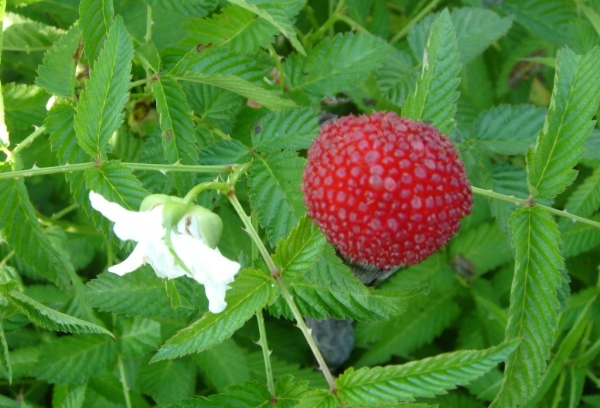Raspberries, it is one of the most popular crops for growing among many summer residents. There are various varieties of this tasty and healthy berries.
One of the most unusual is Tibetan raspberry.
Table of contents
Description of the variety
Tibetan raspberry is a wild variety of this crop.. The first mention of it as a garden plant was made in Japan in the 19th century, and North China and the Himalayas are also considered the ancestral home.
The second name of this variety strawberry raspberry. It is due to the fact that this berry is a hybrid of two cultures, both in appearance and taste.
Such a shrub differs in frost resistance and unpretentiousness to weather conditions. You can grow in almost any climate, the main thing is to maintain favorable conditions, such as the absence of a sharp wind and the prevention of soil drought.
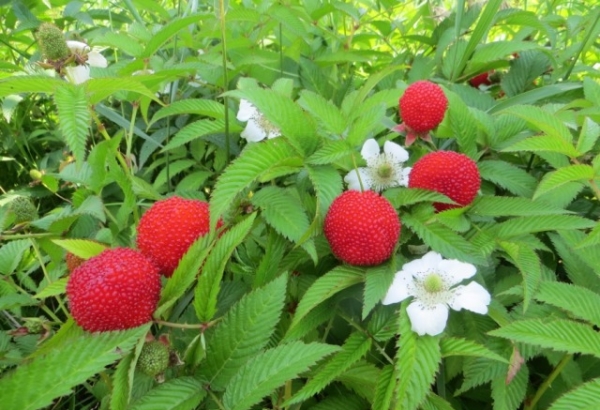
Characteristics of the Tibetan Rosolist (strawberry) raspberry
In the wild, such a raspberry can reach 3 meters in length, but garden, domesticated plants are more modest in size and reach a height of no more than 1.5 meters. Crohn creates a rounded shape.
Leaves - the biological name of such a shrub is raspberry Rosolithic, which clearly indicates the similarity of this indicator in the two cultures.
The leaves are painted in dark green with yellowish streaks, collected 5-7 pieces on one petiole, along the edges are small notches.
Flowers - raspberries of this variety form white, single flowers, which differ in large size, they can be up to 5 centimeters in diameter. Consist of 5 petals.
The flowering period lasts until mid-autumn and new inflorescences seem to replace already ripe berries.
Berries - juicy, have a sweet-sour taste and a delicate, strawberry flavor. The size of the berries can reach the size of a walnut, the color is coral-red.
Spikes - large and sharp, are not the most pleasant distinctive feature of this variety.
Working with Tibetan raspberries, do not forget about the presence of thorns, always wear rubber gloves and be extremely careful.

Advantages and disadvantages, useful properties
Fruits have an unusual taste, reminding a blackberry with light notes of pineapple. This combination is rarely found in nature.
The appearance, long fruiting and flowering, which lasts from mid-summer to the end of September, make Tibetan raspberry the perfect complement to various landscape designs.
With its help, you can build an alpine slide or make a hedge.
Unpretentious care. This variety does not require special attention and constant observation. It is necessary only to water the shrubs in time, so that he would continue to delight with his appearance and tasty fruits.
Poorly transported, therefore, Tibetan raspberry is extremely rare on the shelves of stores.
The creep of the root system refers more to minuses than to pluses, because if you do not stop the disorderly growth in time, you will have to dig up the plot, freeing up space for other cultures.
Sharp spikes can easily hurt a persontherefore, working with this variety can be dangerous and unpleasant.
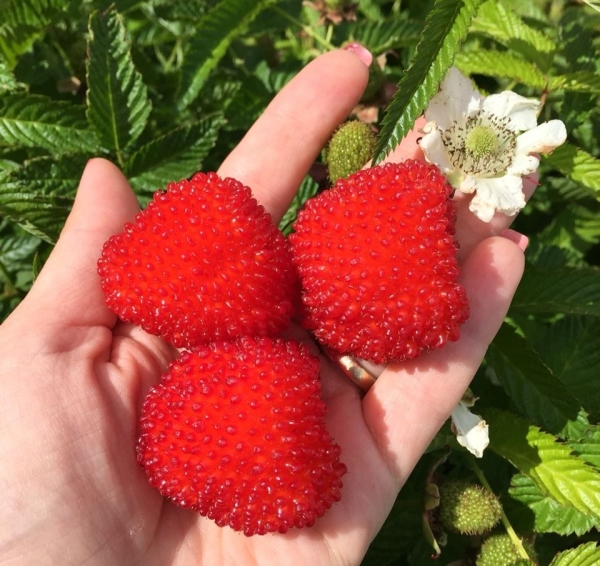
Features of planting a Chinese hybrid
When choosing saplings it is necessary to pay attention to the external state.Any damage, in the form of rolled sheets or yellowing, may indicate a damage to the plant.
This bush is unlikely to take root on the site and soon die.
Depending on the climate Tibetan raspberry can be planted both in sunny areas and in partial shade. It is worth noting that she likes warm and sunny weather. You should not choose lowland places where melted snow and puddles accumulate after the rain.
Best to plant shrubs in late September - early October. It is during this period that the plant is most likely to remain viable.
Prefers fertile land with a neutral or alkaline reaction. For the best arrangement of raspberries in a new place, it is recommended to bring one bucket of peat into each planting pit and half a bucket of manure for half a bucket.
After placing the seedling in the hole, you need to fill it with fertile soil and water it abundantly.
This variety has a very developed root system. And so that raspberries do not crowd out other cultures need to provide a clear framework of growth.
To do this, along the perimeter of the landing, a barrier of slate depth of 1 meter is driven in.

Care
Tibetan raspberry is not much different from other varieties of this plant. She is unpretentious and requires minimal attention.
Watering
The best thing carry out this procedure dailyto prevent drying out. On average one bush takes 10 liters of water.
Tibetan raspberry does not tolerate dry and hot weather. Therefore, in such periods, in addition to root irrigation, rain is also carried out.
Top dressing
Feed the plant must be twice a year:
- In the spring, immediately after the snow has melted, ammonium sulphate granules should be scattered around the root zone.
- In the fall, potassium sulphide is used. It does not need to be diluted, it is applied directly in a dry form.
To make the fertilizer as efficient as possible, after the procedure it is necessary to cover the root zone with mulch from peat, manure or humus.
Loosening
The Tibetan raspberry has a very delicate and fragile root system, which is also very close to the ground, therefore loosening the land must be very careful.
The same goes for weed removal. These actions are best done manually, without the use of special tools.
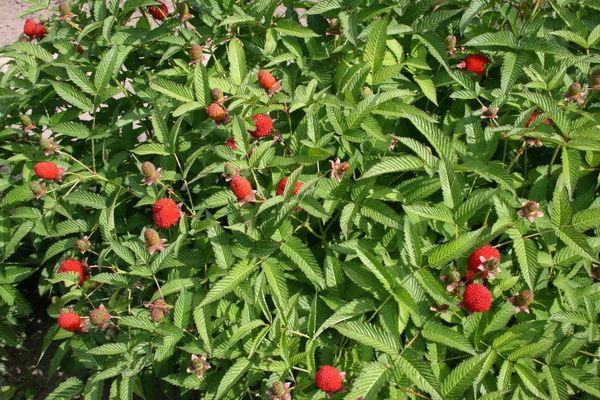
Preparing for the winter
This variety does not require any special preparation and the creation of special shelters. In the autumn, after the green part of the plant dies out, it must be completely cut off, leaving the branches 4-5 centimeters high.
After which they need cover with spruce branches and cover with soil. Such preparation will help the shrub survive even the lowest temperatures.
Breeding methods
Tibetan raspberries can be propagated using various techniques and technologies.
Cuttings
The best time is autumn. post harvest harvest. It is necessary to dig up a bush and divide it into several parts, and on each part there must be a kidney.
Then the resulting seedlings are placed in a hole, the size of which exceeds the dimensions of the roots.And at the end, all adult stems are cut off, leaving a small stump, up to 3 centimeters high.
Rhizomes
Usually, around adult plants whose age exceeds five years, a lot of young shoots accumulate.
This type of breeding is suitable for both autumn and spring. The main thing is to make sure that raspberries are either already dead or not yet entered the phase of active growth.
Seeds
This method is the most complex of all, requires a lot of strength and patience:
- From overripe berries need to carefully select the seeds. To do this, the fruit should be slightly crushed and left in this form for 2-3 days.
- After that, the resulting gruel is washed with a sieve. The resulting seeds must be dried.
- Then they need to be placed in containers with sand to a depth of 2-3 mm.
- This design is put in the fridge for a month, and then moves to room temperature.
- Then you need to monitor the favorable soil moisture, and after 3-4 weeks the first shoots will appear.
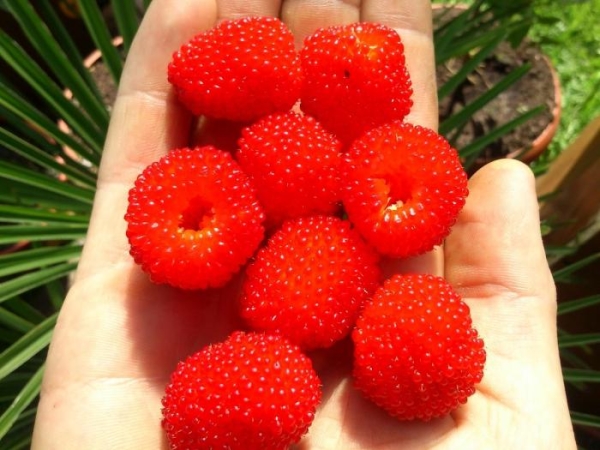
Diseases and pests
In this aspect, Tibetan raspberry is not much different from other representatives of this culture.
Prevention measures will be constant and quality care.which is expressed in the following factors:
- timely feeding;
- frequent weeding;
- preventing overmoistening of the soil;
- cleaning of dry branches and foliage, because it is in it that various parasites can live.
But if the plant was still affected, To get rid of parasites, the following measures should be taken.:
- DDT, Malathion and Detoil solution will be effective for pest control;
- a solution of copper sulphate or Brodsky liquid will help to get rid of diseases;
- the most practical method is to remove infected parts of the plant. They must be burned, because the use of diseased branches and leaves to make composts or mulch can worsen the situation.
The most common ailments that affect raspberries:
- Raspberry-strawberry weevil - it feeds on the leaves and flowers of the plant and can lead to a significant loss of harvest.
- Raspberry beetle - likes to eat fruits and leaves.
- Anthracnose - It manifests itself in the form of light brown spots of oblong shape, which gradually increase.
- Yellow mosaic.
- Root cancer - is a bacterial disease, it affects the root system of young and weak plants.
- Chlorosis - yellowing and gradual dying off of the foliage of the plant begins.
Raspberry Rosolist (Tibetan or Chinese), description of properties:
Many gardeners consider themselves to be fans of this bush for its incredible taste and beautiful appearance.
